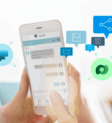Transforming Omnichannel Customer Service With Chatbots

With the onset of COVID-19, consumer buying worldwide shifted to digital platforms. Digital platforms are increasingly being used to interact with brands, view products, get information, check prices, and make purchases. Moreover, with the uncertainty surrounding the pandemic, they expected a super quick and highly efficient customer service to resolve their queries. They no longer tolerated traditional service approaches like frustrating IVRs, frequent agent transfers, or having to repeat their questions again and again to get the support they required.
Today’s customers desire convenient services through a variety of channels. For example, they may check a product’s features on Facebook, send an email to request more information, make purchases through a website, and seek technical assistance through IVR.
Therefore, an omnichannel customer strategy that integrates all communication channels has become the foremost priority for organizations. It is not only crucial for companies to be present on a particular channel; rather, it is also imperative to adapt to the unique formatting of each customer touchpoint and coordinate communication across channels to create a personalized and holistic brand experience.
A study by the Aberdeen Group revealed that organizations with a sustained omnichannel engagement strategy retain an average of 89% of their customers. In comparison, those without one retain an average of 33% only. Moreover, companies with omnichannel strategies experience 23 times higher rates of customer satisfaction.
An effective way to deliver fast yet personalized omnichannel experiences is through AI chatbots. So, let’s find out how organizations are transforming omnichannel customer service with chatbots.
Omnichannel Chatbots: Build Once, Deploy Anywhere
Customers expect their demands and needs to be met, even when they use different channels to communicate, and that’s where omnichannel chatbots come into the picture.
An omnichannel chatbot needs to be built just once and can then be deployed across multiple channels, including email, customer-facing websites, Facebook Messenger, Twitter, WhatsApp, mobile apps, and even voice assistants, such as Alexa and Google Home, and works seamlessly across all channels.
Enterprises today are using low-code chatbot builder platforms to build and deploy omnichannel chatbots. This means business teams can implement chatbots within a matter of a few weeks and little reliance on IT teams.
Omnichannel chatbots leverage technologies like artificial intelligence, machine learning, natural language processing (NLP), and natural language understanding (NLU) to comprehend customer queries, learn from past interactions, and store information from each user in a centralized database.
Once the data is collected, the bots access this information in real-time to deliver personalized conversational experiences to customers. Since bots retain the context of the original conversation, customers can easily switch from one channel to the next without the need to start over.
Omnichannel bots make customer interactions smoother and more consistent by –
- Functioning seamlessly across virtually all channels in the digital landscape
- Engaging in personalized conversations by understanding each customer’s individual needs and situation
- Accessing real-time data and ensuring information consistency across all channels
- Solving simple to more complex queries
- Adjusting to new information and customer preferences over time
- Escalating queries to human agents when needed.
Benefits of omnichannel chatbots
1. Improved customer satisfaction
Omnichannel chatbots help organizations increase CSAT levels in more ways than one. Keeping up with the increased use of messaging applications and social media platforms, bots can now be integrated with channels like WhatsApp, Facebook Messenger, Telegram, etc. Bots can then assist customers in locating the products that suit their needs, answer questions regarding payment, delivery status, etc., carry out simple transactions on the customer’s behalf, or solve other queries. Or they may transfer the request to a human agent or schedule an agent call-back if needed.
Moreover, bots can handle multiple requests at once to provide customer support at scale, 24X7, and at lower costs.
In addition to delivering passive customer interaction, wherein bots only engage with customers when contacted, organizations can stay a step ahead by proactively reaching out to customers regarding new products or issues they might be facing and improve brand perception in the long run.
2. Fast response
An omnichannel bot can provide an immediate response, within seconds, on any channel it is deployed. According to an Inside sales research, there is a 10x reduction in the odds of retaining a customer, even if you wait 5 mins after the lead makes contact. Given these stats, it becomes prudent for all organizations to provide swift and accurate responses to customers, both current and potential.
By leveraging its machine learning capabilities and drawing insights from already stored data, an omnichannel bot can provide quick, personalized, and consistent answers to customer queries in real-time.
3. Increased revenue
If customers receive exceptional service, they remain satisfied and loyal to your brand and buy more. According to a Harvard Business Review report, a 5% increase in customer retention amounts to an increase of up to 95% in the company’s annual earnings.
The wholesome, interactive, and engaging experience offered by omnichannel chatbots can thus accelerate business growth.
4. Data collection
Omnichannel bots collect customer information from various channels and store all of the data in a centralized database. Such data provides insights into customer buying behavior, past interactions, requirements, etc., allowing companies to plan more focussed and strategic marketing and sales initiatives.
Go Omnichannel Today!
Consumer behavior is evolving, and establishing new ways to connect with them has become more critical than before.
By adopting an omnichannel strategy with the help of chatbots, companies empower customers to engage with them on the channel of their choice and create more meaningful, effortless, and successful user experiences. Establishing consistent support across all channels leads to enhanced customer satisfaction, higher brand loyalty, and greater revenue.
On top of that, the data you collect can help you establish more targeted and improved outreach and sales practices.
At Acuvate, we help clients build and deploy omnichannel bots with our enterprise bot-building platform called BotCore. BotCore’s core capabilities and features include –
- With minimum coding requirements and pre-built connectors, it is easy to deploy chatbots, and also differentiate responses across channels by using channel-specific interface elements. A single configuration is enough for deployment across multiple channels.
- BotCore’s chatbots support multiple languages, like French, German, Italian, etc. so you can reach and engage a wider consumer base.
- Through automatic handling of API requirements, BotCore’s chatbots can connect to various channels, such as Facebook, SMS, email, etc. You need to simply click on the required checkboxes, and the deployment is done.
- BotCore’s machine learning (ML) capabilities help chatbots retain the context of the conversation, allowing users to switch channels without the need to begin the conversation from scratch.
If you’d like to learn more about this topic, please feel free to get in touch with one of our enterprise chatbot consultants for a personalized consultation. You may also be interested in exploring our chatbot builder platform (BotCore).
Abhishek is the AI & Automation Practice Head at Acuvate and brings with him 17+ years of strong expertise across the Microsoft stack. He has consulted with clients globally to provide solutions on technologies such as Cognitive Services, Azure, RPA, SharePoint & Office 365. He has worked with clients across multiple industry domains including Retail & FMCG, Government, BFSI, Manufacturing and Telecom.






Abhishek Shanbhag